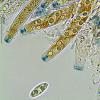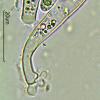
25-12-2013 22:52
 Rubén Martínez-Gil
Rubén Martínez-Gil
Hola a todos.Pongo fotos de una recolecta sobre ma

15-12-2013 11:50
Peter ThompsonHello Everyone,I have found some effuse fruit bodi

16-12-2013 19:34
 Joop van der Lee
Joop van der Lee
Found on horse dung. Most of the time I found th

24-12-2013 21:19
Hello friends, someone would have some work on Tri

24-12-2013 14:04
 Alex Akulov
Alex Akulov
Dear FriendsCan you help me with identification of

23-12-2013 23:42
 Danny Newman
Danny Newman
Hello AscoFrance,I wish to apply responsible names

27-08-2013 21:51
Hello,Can somebody help me with this one? On dee

22-12-2013 19:31
Rajamaki MarttiDoes anyone have any good idea about this mushroom
Rutstroemia ?
Rubén Martínez-Gil,
25-12-2013 22:52
 Hola a todos.
Hola a todos.Pongo fotos de una recolecta sobre madera sin identificar, en bosque mixto de P. nigra, Q. faginea y Q ilex, con hiedras y bastantes arbustos diferentes.
Ascas inoperculadas, amiloides (IKI+), pleurorrincas, de 150-180 x 9-13 micras.
Esporas gutuladas, elipsoidales, de 15-19 x 5,5-7 micras.
Paráfisis filiformes, poco o nada engrosadas en el ápice, septadas, alguna bifurcada en tercio superior, con contenido interno de color pardo.
Gracias por su ayuda
Un saludo
Rubén
Rubén Martínez-Gil,
25-12-2013 22:59
Hans-Otto Baral,
26-12-2013 10:30

Re : Rutstroemia ?
Hi Ruben
this is one of the mysteries of Rutstroemia. Is this R. firma or not? Often R. forma has curved spores, but sometimes like yours, and sometimes mixed.
Are you sure that the last image shows the ectal excipulum? The broader hyphae of the beforelast could rather belong to it. Important would be to know if there is any gel in the ectal excipulum, which is best seen in a section.
Zotto
this is one of the mysteries of Rutstroemia. Is this R. firma or not? Often R. forma has curved spores, but sometimes like yours, and sometimes mixed.
Are you sure that the last image shows the ectal excipulum? The broader hyphae of the beforelast could rather belong to it. Important would be to know if there is any gel in the ectal excipulum, which is best seen in a section.
Zotto
Rubén Martínez-Gil,
26-12-2013 15:33
Hans-Otto Baral,
26-12-2013 17:08

Re : Rutstroemia ?
yes, I also suspect that these narrow hyaline hyphae with anastomoses are embedded i n gel and belong to the central layer of the ectal excipulum.
It looks similar to my drawing here. Also Yannick had a find on Betula with such spores (X.2009) or Bernd Fellmann on ?Castanea twig (Toscana, X.07).
Would be interesting to make a DNA study on these different spore types.
Zotto
It looks similar to my drawing here. Also Yannick had a find on Betula with such spores (X.2009) or Bernd Fellmann on ?Castanea twig (Toscana, X.07).
Would be interesting to make a DNA study on these different spore types.
Zotto
Rubén Martínez-Gil,
26-12-2013 20:29

Re : Rutstroemia ?
Sí, parece que su dibujo es de una recolecta similar a la mía.
Gracias por todo.
Un saludo
Rubén
Gracias por todo.
Un saludo
Rubén
















